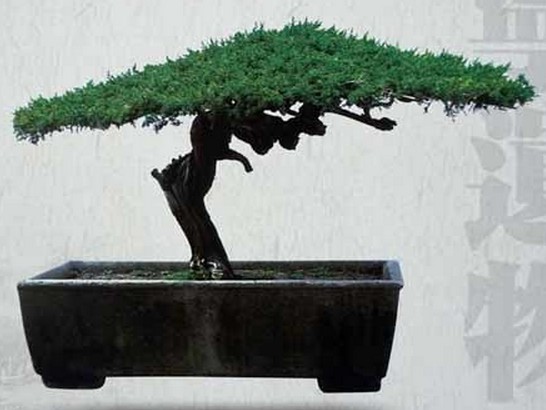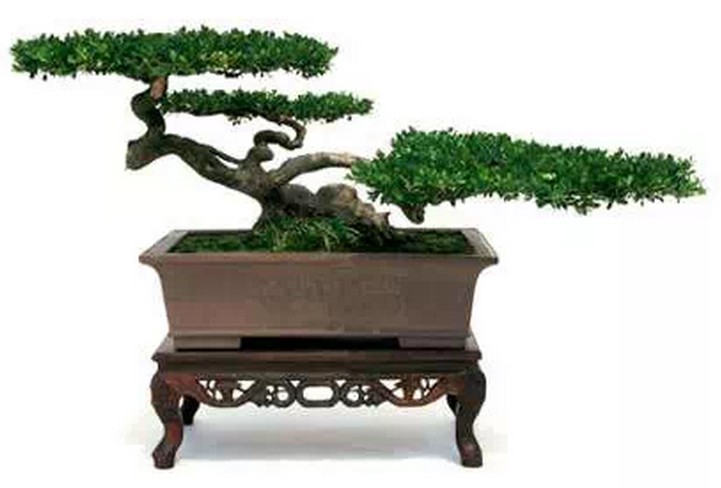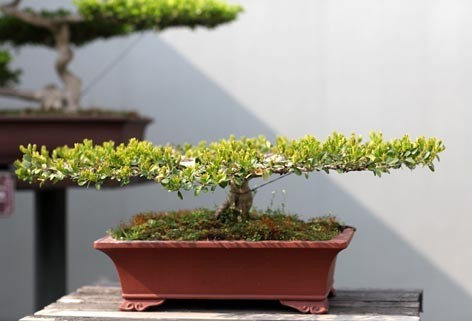Antique Yangpai bonsai in Ming and Qing dynasties
Family-style bonsai workshops appeared in Yangzhou in the Qing Dynasty. In the 1950s and 1960s, Yangzhou Garden Department collected bonsai from the folk, and successively collected 24 bonsai pots in Ming and Qing dynasties. These living cultural relics have become an important collection of today's Yangpai Bonsai Museum.

1. The relics of juniper at the end of Ming Dynasty and Tianning Temple in Yangzhou.
2. The rhyme of the late Ming Dynasty, Yuanbai. The bonsai style of Yang School began to form in the Ming Dynasty. This work is a relic of the late Ming Dynasty, about 400 years ago.
3. Tengyun, Huang Yang. A typical Yangpai bonsai masterpiece, the tree is more than 280 years old. With alpine pine as a copy, it is made of brown silk fine binding and fine cutting. The twigs in his "Cloud Film" reach "one inch and three bends", which shows the profound ability of the traditional Yangpai bonsai. The gold medal of the second China Bonsai Competition Exhibition in 1989 and the gold medal of 1990 Osaka International Horticultural Expo in Japan.
Xiuyun, Huang Yang. Yangpai bonsai prevailed in Yangzhou in the Qing Dynasty, and its cutting skills were excellent. Xiuyun is a relic of the late Qing Dynasty. The second China Bonsai Exhibition in 1989 inherits the tradition Award, and the Gold Award of the third International Garden and Flower Expo in 2002.
5. Xingyun, Huang Yang. The relics of the middle Qing Dynasty are "Qiaoyun style" and "cloud film" with distinct layers. 1999 Kunming World Horticultural Exposition Bronze Award.
6. Born out of nowhere, round cypress. The relics of the mid-Qing Dynasty retain the charm of the pioneering style of Yangpai bonsai. The gold medal of the 6th China Bonsai Exhibition in 2004.
7. Canglong out of the valley, round cypress. The relics of the Qing Dynasty have been around for more than 200 years. The first prize of the Fifth China Bonsai Competition Exhibition in 2005.
Time: 2019-06-04 Click:
- Prev

The forming History of Yang School Bonsai Art
Yang School bonsai art was formed in the Ming Dynasty and matured in the Qing Dynasty, drawing on natural materials, imitating nature, absorbing Chinese traditional humanistic values and aesthetic ideas, and integrating poetry, calligraphy, painting and skills. Inherit the context of Chinese bonsai art with elegant, freehand brushwork style and fine cutting, one inch and three bends.
- Next

Protection of Yangpai Bonsai works
Yangzhou Yangpai Bonsai Museum has a number of ancient bonsai works. They are living cultural relics, and although they have gone through hundreds of years of changes, they still maintain their original vibrant form, which is also inseparable from the use of Yangpai bonsai technology for conservation, management and re-creation.
Related
- Fuxing push coffee new agricultural production and marketing class: lack of small-scale processing plants
- Jujube rice field leisure farm deep ploughing Yilan for five years to create a space for organic food and play
- Nongyu Farm-A trial of organic papaya for brave women with advanced technology
- Four points for attention in the prevention and control of diseases and insect pests of edible fungi
- How to add nutrient solution to Edible Fungi
- Is there any good way to control edible fungus mites?
- Open Inoculation Technology of Edible Fungi
- Is there any clever way to use fertilizer for edible fungus in winter?
- What agents are used to kill the pathogens of edible fungi in the mushroom shed?
- Rapid drying of Edible Fungi

